BILL Crown switch with 4 smaller fuses within
Nasty old metal switch unit containing 4 smaller ceramic fuses. Removed from a bungalow in 2009, this unit supplied all of the circuits in the property.
External view
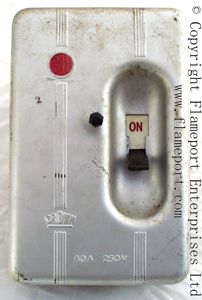 External view. The casing is sheet metal, with embossed details such as the name, rating and various decorative patterns.
External view. The casing is sheet metal, with embossed details such as the name, rating and various decorative patterns.
The silver finish is paint, and significant corrosion can be seen on the cover, due to the damp wall this was fixed to.
The small black knob near the centre unscrews to release the cover. The cover can only be removed with the main switch Off, due to the T shaped hole around the switch.
A spring mechanism prevents the switch being moved unless the cover is fixed in place. This both prevents the fuses being live with the cover removed, and ensures the cover can be replaced.
Internal view
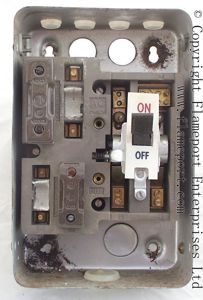
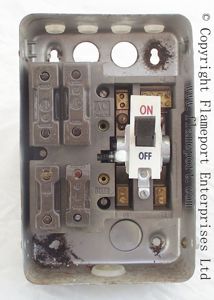 Front cover removed. The main supply entered at the bottom, connecting to the two lower terminals marked L and N. Outgoing cables connected to each fuse, with the neutrals connecting to the block at top right (above the switch).
Front cover removed. The main supply entered at the bottom, connecting to the two lower terminals marked L and N. Outgoing cables connected to each fuse, with the neutrals connecting to the block at top right (above the switch).
There is no separate earth block - earth connections would be made to the metal case of the device, bottom right, top right and top left. Note the excessive corrosion around the rear fixing holes.
Fuses removed
In the second picture, two fuses have been removed. Note the outgoing connection is at the top for the upper 30A fuses, and at the bottom for the lower 15A fuses.
The white pads where the fuses fit are probably asbestos.
The bottom right fuse has a screw cover missing - that screw would be live when the unit was energised.
Fuseway and fuses detail
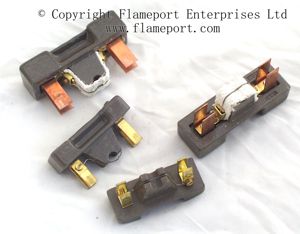
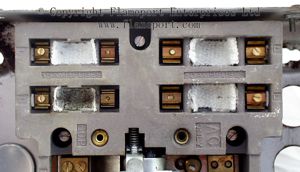 Here, all of the fuses have been removed. One of the 15A ways has clearly failed in the past, resulting in molten copper and other burnt materials being deposited on the white pad.
Here, all of the fuses have been removed. One of the 15A ways has clearly failed in the past, resulting in molten copper and other burnt materials being deposited on the white pad.
The 4 fuses supplied a cooker circuit (30A), sockets (30A), immersion heater (15A) and lighting (15A, although should have been 5A).
This unit was probably original to the property, which was constructed in the late 1950s/early 1960s. The property has since been completely rewired.
The fuses themselves are rewireable types. The 30A versions have white (asbestos?) pads, the 15A versions do not.
Note the damaged fuse wires on the 15A types - although intact, they have clearly suffered from overheating.


